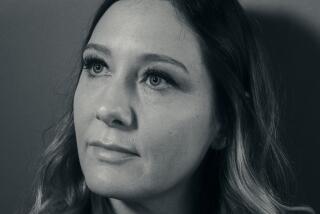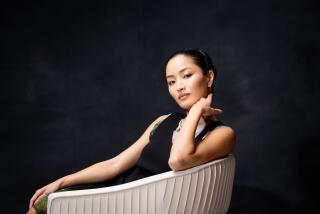Kayo Hatta, 47; Filmmaker Who Directed, Co-Wrote ‘Picture Bride’
- Share via
Kayo Hatta, who co-wrote and directed “Picture Bride,” an award-winning film about a young Japanese woman’s struggle to adjust to an arranged marriage and the hardships of Hawaii plantation life, has died. She was 47.
Hatta, who lived in Encinitas, Calif., died July 20 in an accidental drowning at a friend’s home in the San Diego area.
A graduate of Stanford University and UCLA’s film school, Hatta labored for five years to bring “Picture Bride” to theaters. The low-budget movie was picked up by Miramax at the Cannes Film Festival and won the Audience Award for best dramatic film at the Sundance Film Festival in 1995.
Drawn to stories that illuminated Hawaii’s complex ethnic heritage, Hatta recently completed “Fishbowl,” a dramatic short film full of angst and comic twists about the coming of age of a rebellious granddaughter of immigrant sugarcane workers.
Based on a novel by Lois-Ann Yamanaka, the 30-minute film premiered at the San Francisco International Asian American Film Festival in March and will be broadcast on PBS next year.
It was Hatta’s third completed dramatic film during a two-decade career that included making documentary films, teaching at UCLA and running a Bay Area film festival.
“Kayo was very exacting as a filmmaker,” said Abraham Ferrer, exhibitions director for Visual Communications, a Los Angeles-based Asian Pacific media arts center, who knew Hatta for more than 15 years. “Her career was not distinguished by a massive volume of work, but she had such a clear idea of how to depict stories and characters that she didn’t lay an egg when she finished something.”
Hatta was strongly committed to making movies that offered authentic portrayals of Asian culture. Much of the dialogue in “Fishbowl” and “Picture Bride” is in Hawaiian pidgin English and many of the actors are Hawaii natives.
In “Picture Bride,” she resisted studios’ suggestions that she give a white male with box-office draw a romantic lead. Not only did she cast Asian actors in the leading roles, but Asian American women filled the top production posts, unprecedented for an American dramatic feature film.
“Her spirit was pretty infectious,” Tamlyn Tomita, one of the stars of “The Joy Luck Club” as well as “Picture Bride,” told The Times this week. “She wanted to make sure this film had as much credibility as it could.”
Lori Kayo Hatta was born in Hawaii and moved to New York City when she was 6. Her father, a Buddhist minister turned restaurateur, opened one of Manhattan’s first sushi establishments in the early 1970s. Her homemaker mother, the family’s official photographer, loaned her Super 8 camera to her daughter to make movies when Hatta was a child.
At Stanford, Hatta majored in literature, earning a bachelor’s degree in 1981. She worked with a documentary film group in San Francisco for several years before honing her skills at UCLA, where she earned a master’s degree in film production in 1991.
Her first movie was a short completed in 1988 called “Otemba” (“Tomboy”), about the conflicts felt by an 8-year-old girl whose father is obsessed with having a son. It was chosen by the Pan-Asian Filmmakers Foundation as one of three “Defining Moments in Asian American Cinema.”
“Picture Bride” began as Hatta’s thesis project at UCLA. During the early 1900s, nearly 20,000 Japanese, Korean and Okinawan women crossed the Pacific to Hawaii to marry Japanese plantation workers after an exchange of photographs.
After their long journeys, many of the brides were crushed to learn that their husbands were not the rich and handsome men that their pictures suggested and that a life of backbreaking labor awaited them.
Hatta and her sister, Mari, interviewed 20 former picture brides who were in their 80s and 90s and wrote a script that aimed for a historically accurate depiction of the marriage system and its impact on Hawaiian culture.
The movie’s main character is a delicate city girl from Yokohama named Riyo, who arrives in Hawaii in 1918 to discover that the man who sent for her is older than her father. Deeply disappointed, she rebels, biting his hand to thwart his sexual advances and refusing to consummate the marriage.
Riyo goes to work for 60 cents a day in the sugarcane fields, where she is taunted by co-workers as well as the Portuguese overseer. She runs away and has a mystical encounter with the ghost of a woman mentor before finding the strength to return to the plantation and start over with her husband on new terms.
“One of the things we were looking at were the limited number of life alternatives young Japanese women had at that time,” “Picture Bride” producer Lisa Onodera said Thursday. “The lesson of the film was that [Riyo] learned to make a full life with what she had. Kayo managed to see that strength in all the characters in her films. She understood Japanese American women so well, with so much tenderness and subtlety.”
“Too often Asian women are portrayed as geishas or some other exotic types,” Hatta told the Chicago Sun-Times in 1995. “I wanted to get away from that ... to show them as real human beings who had fears and dreams, sexual desires.”
Riyo was played by Youki Kudoh, a Japanese pop idol known to American audiences for her role as an Elvis devotee in the quirky Jim Jarmusch-directed movie “Mystery Train.”
“Picture Bride” also featured Tomita as Riyo’s ill-fated mentor and Japanese actor Akira Takayama as Riyo’s husband, Matsuji.
The greatest coup, however, may have been the casting of the legendary Japanese actor Toshiro Mifune, star of such classics as “The Seven Samurai” and “Rashomon,” in a cameo role. Mifune played a benshi, or traveling silent film narrator, who comes to the sugarcane fields to entertain the workers.
As an independent filmmaker on a shoestring budget, Hatta could not pay much. Her initial financing came through grants -- $40,000 from the National Asian American Telecommunications Assn., $25,000 from the National Endowment for the Arts, $50,000 from the National Endowment of the Humanities and $322,000 from the state of Hawaii. When the money ran out halfway through production, Kudoh persuaded the president of a Japanese lingerie firm she had modeled for to invest the final $600,000 needed.
Hatta also sought small donations through a grass-roots fundraising drive aimed at Hawaiian islanders, who were promised a screen credit for a contribution of at least $5.
The effort, which raised money and in-kind donations of everything from food to sewing services, attracted so many contributors that it took 11 minutes to roll through the credits.
Miramax spent $500,000 for post-production refinements before distributing the movie in the United States. Its investment brought the total budget to $2 million, modest by Hollywood standards.
Nevertheless, New York Times critic Janet Maslin wrote that “Picture Bride” looked “remarkably lovely considering that budget” and had “a pleasing warmth and sincerity.” Kevin Thomas of the Los Angeles Times said Hatta was “not only a visionary but also a fine director of actors.”
Besides her sister Mari Hatta of San Francisco, Hatta is survived by her mother, Jane Matano Hatta of Honolulu; sisters Julie of San Francisco and Carrie Hatta of Honolulu; half sisters Eri Hatta of Alameda, Calif., and Chika and Yuki Hatta of Las Vegas; and fiance Douglas Hetrick of Leucadia, Calif.
More to Read
Only good movies
Get the Indie Focus newsletter, Mark Olsen's weekly guide to the world of cinema.
You may occasionally receive promotional content from the Los Angeles Times.








